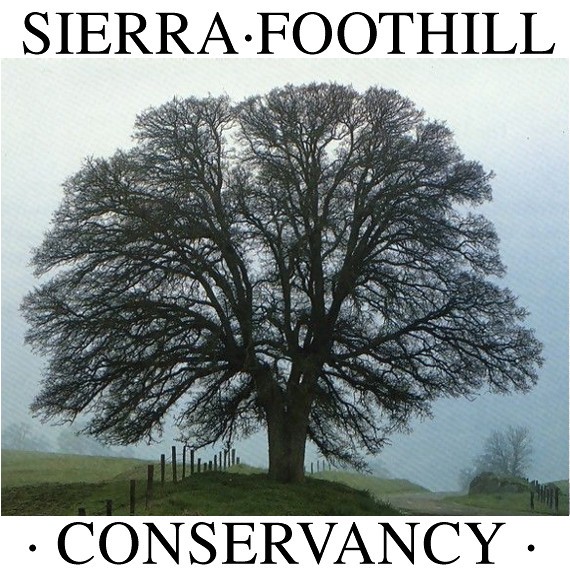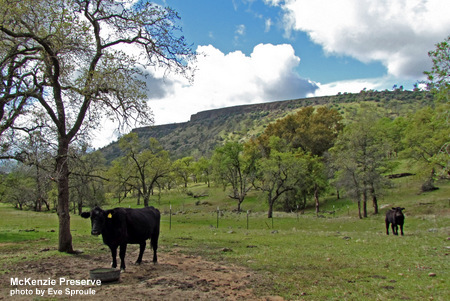According to the Natural Resources Conservation Services (NRCS), rangelands are defined as lands on which the indigenous vegetation is predominately grasses, grass-like plants, forbs, and possibly shrubs or dispersed trees. Rangelands include grasslands, savannas, shrublands, desert, alpine communities, and meadows. Some rangelands may be privately owned ranches where cattle and other livestock graze. In California there are organizations dedicated to protecting these working lands in order to preserve the natural habitat, and the ranching culture. These organizations protect the ranchers, the lands, the wildlife and the environment in our state, while ensuring that working lands aren’t subdivided and developed.

The SFC
One of the organizations diligently working to conserve these lands is the Sierra Foothill Conservancy (SFC). Rangeland manager of SFC, Billy Freeman, states that SFC’s purpose is to “conserve natural and cultural resources in the central Sierra Foothills region. We are accomplishing this through holding 24,288 acres in conservation easements with local landowners and stewarding 7,500 acres in fee title lands. SFC also has performed meadow restoration, fuels reduction and native plant restoration projects on many of these properties.” Freeman, who is a California Certified Rangeland Manager and a Certified Professional in Rangeland Management has a passion for rangeland stewardship and all that that entails.
“My work with SFC allows me to work directly on Rangelands managing their grazing operations and rangeland monitoring activities. I also contribute to conservation efforts by working with landowners on conservation easements. Landowners are often multiple-generation ranching families who have a deep cultural and spiritual connection to the land. Assisting them in conserving and stewarding their properties is very meaningful work. I draft grazing management plans for sensitive wildlife species mitigation projects and other conservation lands. Lastly, I assist in restoration and wildlife habitat enhancement stewardship projects. My passions are focused on stewarding rangelands, cattle, horses, stockmanship and grazing management. I enjoy my work with SFC and also helping out neighbors and friends with their cattle work.”
“My goal is to positively impact rangelands in California through stewarding the ecosystems and helping to conserve natural and cultural resources.”
Rangelands and their Ecosystem Resources
Rangelands provide great ecosystem services, Freeman notes.
“Rangeland Ecosystem services consist of food and Fiber production, Biodiversity, Climate regulation, wildlife habitat, clean air, clean water, recreation, cultural and spiritual resources, scenic open space and conservation.”
“The value of some ecosystem services cannot be monetized. Monetization has already occurred on the remainder. The services that are the most valuable to society are the ones that do not carry any monetary value (Air, water, climate regulation). These services depend on ecosystem functioning (ecosystem process function). The emerging concept of Regenerative agriculture seeks to enhance ecosystem functioning and soil health. How are we going to place value on regenerative practices? Currently we have NRCS, HSP and select other grant programs. Carbon markets are emerging although measuring soil C is challenging. Niche marketing and certifications has also been used to provide economic incentives to producers to adopt regenerative practices. Consumer demand and public perception are, in my opinion, the most important factors that will enable regenerative agriculture to expand.”
Rangeland Influence
There is a disconnect between priorities of those who manage the rangelands and those who don’t. This causes issues when it comes to forming policy, but Freeman stresses that rangelands benefit both rural and urban areas and are thus very important for our state. “Rangeland politics are largely controlled by urban environments because of voting influence. Most people who manage Rangelands, however, live in rural areas. Still, most of the ecosystem services benefit is experienced by those in urban areas.”
Freeman explains that California is comprised of approximately 100 million acres of land. 63 million of that is rangeland, and grazing livestock run on about 40 million acres. Only about 45% of rangeland, or 17.9 million, is privately owned and he believes that every person involved with rangelands has an important role.
“Every person or entity that owns rangelands or influences their management is a stakeholder in California rangelands in general. Every stakeholder is a resource whose partnership can bring about positive change.”
Who is involved?
And there are many organizations and people involved with rangelands:
- Federal ownership (US Forest Service and Bureau of Land Management)
- State and regional ownership, like state or regional parks
- Public municipalities (East Bay Municipal Utilities District)
- Non-governmental Organizations (land trusts, environmental groups like the Audubon Society)
- Tribal lands
- Universities
- University of California Cooperative Extension
- Professional organizations
- Public opinion
- Environmental advocacy groups
- Conservation groups
- Agencies (regulatory and non-regulatory- USFS, US Fish and Wildlife Services, Army Corps, California Department of Fish and Wildlife, NRCS, California Association of Resource Conservation Districts)
- Range Management Advisory Committee and the Board of Forestry and Fire Protection
- Irrigation Districts and grassroots networks and organizations such as State Coastal Conservancy.
- Regional Water Quality Control Boards for policy and enforcement
With so many influential players working to prioritize their needs for rangelands in California, it is important for organizations, like SFC, to be a voice for the ranches and the landowners.

Who Protects Rangelands?
SFC works diligently to protect the grasslands, foothills, and forests between Yosemite and Kings Canyon National Parks and has conserved 31,788 acres to date.
SFC isn’t the only organization working to protect the working lands in California, there are many throughout the state, including the California Rangeland Trust, which has conserved over 342,000 acres of working lands since 1998. With California’s population expected to rise significantly in the coming years, rangelands are threatened by encroaching subdivisions and urban development. Volunteering, donating, and supporting land trusts such as Sierra Foothill Conservancy, means we have an opportunity to impact our working lands, and environment, positively and ensure they remain working lands in perpetuity.
Other Involvement
SFC also offers many interactive guided hikes throughout the year to view the wildflowers, birds and nature. Along with their dedication to preserving working lands, and their involvement in the local community, Freeman explained that SFC also operates the Sierra Lands Beef, LLC.
“Sierra Lands Beef is an LLC owned by SFC which was formed to steward conservation lands using grazing and animal impact. We raise grass-fed beef which is marketed direct to consumer during late spring and summer. SLB manages seasonal cattle on SFC preserves and select conservation easements. We provide full care for the animals and use a planned grazing approach to accomplish specific ecological objectives on each property.”
To learn more about Sierra Foothill Conservancy, head to their website at sierrafoothill.org and follow them on Instagram and Facebook at Sierra Foothill Conservancy.







